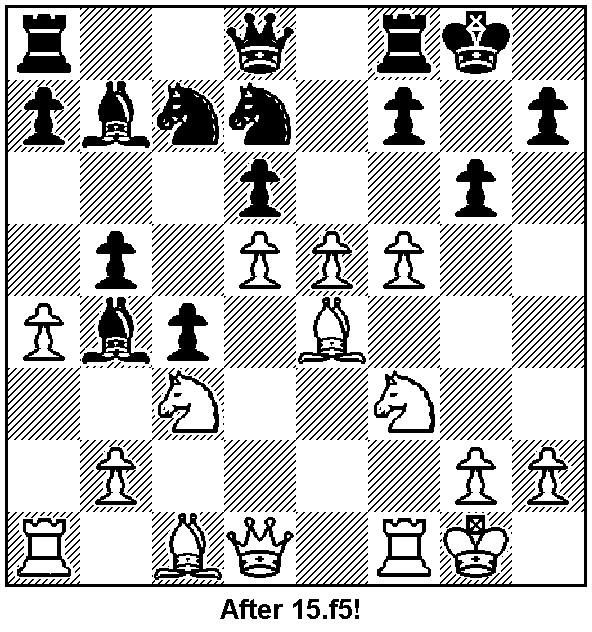At the recent SuperNationals, the best performing Massachusetts player was Westborough High School senior Andrew Liu. Despite being relatively inactive for the past year, he tied for first in the K-12 section with five other players, with 6-1 scores. Andrew received the fourth-place trophy on tie-break. He also won the 2016-17 MACA Spiegel Cup High School Championship and will represent Massachusetts at the Denker Tournament of High School Champions this summer.
Today’s game is Liu’s best effort in Nashville. It was a crucial fifth-round encounter with the higher rated Praveen Balakrishnan, a 15-year-old international master from Virginia. In a very tense struggle, Liu held his composure better and let Balakrishnan make the last mistake. Today’s notes will incorporate a few of Liu’s (AL) annotations.
2017 SuperNationals, Nashville
Andrew Liu (2324) - Praveen Balakrishnan (2480)
1.d4 Nf6 2.c4 e6 3.Nc3 Bb4 4.f3 “My favorite variation against the Nimzo. I prepared it especially hard for this tournament AL’’ 4...c5!? Black’s sharpest reply. The most popular choice here is 4…d5. 5.d5 b5!? 6.e4 0–0 “One of the sharpest variations AL’’ Possible aggression to a fault. Safer is 6...bxc4. Black seems to be hell-bent on making White pay for that slow 4.f3 7.e5 Ne8 8.f4 exd5 9.cxd5 d6 10.Nf3 Nc7 “I think 10…c4!? is a better try.’’ - AL’’ 10...Bg4 is also interesting 11.a4! “I actually found this move as a novelty, but recently it was used by Mamedyarov against Hou Yifan (2017 FIDE Grand Prix Sharjah) “The idea is that it acts as a waiting move, drawing the Black bishop to b7 while also pressuring the queenside pawns. AL’’ 11...Bb7 12.Bd3 g6 It’s interesting and very much an engine discovery that 13.Bxh7+ after 12...Nxd5 is unclear: 13…Kxh7 14.Ng5+ Kg8 15.Qh5 Qxg5! 16.fxg5 Nxc3 17.0–0 g6 18.Qg4 Nc6 and Black’s well-coordinated pieces seem to give him at least equality. 13.0–0 c4 14.Be4 Nd7 15.f5! Bc5+ “15...Bxc3 16.bxc3 dxe5 17.Bg5 f6 18.Bh6 g5 19.Bxf8 Qxf8 20.Nd2 Qc5+ 21.Kh1 Nxd5 22.axb5 Nxc3 23.Qc2 Nxe4 24.Nxe4+– (probably closer to +/= CC) was the main line of my preparation. AL’’ 16.Kh1 b4 17.Nb5 Nxb5 18.axb5 dxe5 19.Bh6 “The quiet 19.Qc2 was better…AL’’ The idea is an eventual Bxg6. 19...Nf6 20.Ng5 “All in! AL’’ 20...Be3! “I had seen this move, but I thought I could try and mix it up with: AL’’ 21.fxg6 hxg6 22.Qf3 “I didn’t know what to think at this point. My calculations were pointing to a winning position, but it’s so tense that I was very nervous what resources lay in the position. AL’’ 22...Nxe4 23.Bxf8 Nxg5 24.Qxe3 Kxf8?! 24...Qxd5 should hold easily after, for example: 25.Qxg5 Rxf8 26.h4 Rd8 27.h5 Qd2! It seems nerves, as well as time, has taken ahold of Black 25.h4 Bxd5? “25...Nh7(!) I thought was winning for white, but actually black has a draw! 26.Qh6+ Kg8 27.Rxf7 Kxf7 28.Qxh7+ Ke8 29.Qxb7 (29.Qxg6+ Kd7 30.Qe6+ Kc7 31.Rf1 Qxh4+)29...Qxh4+ - AL’’ …with a perpetual check. Also, 25…Kg7 should hold: 26.hxg5 Qxd5 27.Qf3 Qxf3 28.gxf3 e4 29.fxe4 Bxe4+ 30.Kg1 Bf5 26.hxg5 Qd7 Hoping for Qh3+, a clear sign of time trouble. Holding or coming close to holding are either 25…Qc7 or Qe7. 27.Kg1 Qe7 28.Rfd1 Be6?? Capitulation as 28...Bb7 holds: 29.Rd2 (29.Re1 e4) 29...Kg8 30.Re1 Re8 31.Qxa7 e4 32.Qe3 c3 29.Qxe5 Threatening both 30.Qh8# and 30.b6 29...Kg8 30.b6 a6 31.Rd4 Qf8 32.Rh4 Qg7 33.b7 Rf8 34.b8Q; 1–0
Kevin Lewis is an Ideas columnist. He can be reached at kevin.lewis.ideas@gmail.com.




